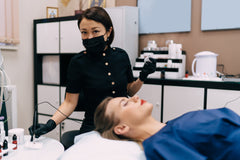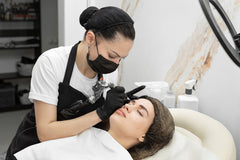📦 Free Shipping for orders of $300 or more. USPS Priority Mail Express days only applies when ordered before 1:00 pm California time. 🔷 Become a BC Member and receive free shipping on all orders no minimums! Free shipping is only offered to USA and Puerto Rico orders. Learn More >> 🔷
📦 Free Shipping for orders of $300 or more. USPS Priority Mail Express days only applies when ordered before 1:00 pm California time. 🔷 Become a BC Member and receive free shipping on all orders no minimums! Free shipping is only offered to USA and Puerto Rico orders. Learn More >> 🔷
Different Types Of Microblading Needles

Different Types Of Microblading Needles
- Admin .
- -
- Apr, 10 , 22
Are you an aspiring microblading artist? Or perhaps you’re entirely new to it and want to learn all you can about this innovative beauty trend. Like any artist, a microblading artist needs a set of tools to create their masterpieces. And to start shaping beautiful eyebrows, you will also need a set of different microblading needles to achieve your desired result.
Needle shapes
Microblading needles come in many different shapes, and each one has its particular use. As a result, many microblading artists have their mix of these shapes in their arsenal to craft their works.
Curved flat or round flat
 When it comes to microblading, artists would be using these blades the most. We call these individual needles on the blades pins. And the pins on a curved flat blade are formed at an angle. So there’s a short pin at one end, and the following pins gradually get taller towards the opposite end. This shape allows each pin to touch the skin at the same time. Artists also use curved flat blades for most fill work during the procedure.
When it comes to microblading, artists would be using these blades the most. We call these individual needles on the blades pins. And the pins on a curved flat blade are formed at an angle. So there’s a short pin at one end, and the following pins gradually get taller towards the opposite end. This shape allows each pin to touch the skin at the same time. Artists also use curved flat blades for most fill work during the procedure.
U-shaped

For this blade, the pins at each end are the shortest and closest to the base. The pins do get gradually taller from the ends towards the middle. Unlike the previous blade, there’s no way that all the pins can touch the skin simultaneously. Its shape can also result in strokes going outside the line or making too long strokes, so mostly, only experienced artists use them effectively for more curved strokes.
Round shader

These blades contain a bundle of pins of the same length in a round shape. The round shader blades are ideal for quick and consistent coverage as artists use it chiefly for fill work. These blades also allow for increased shade density. Larger ones are primarily for larger areas, while smaller ones are perfect for thinner brows and filling tail ends.
Flat shader

The flat shader blade has pins that are of the same height. Artists mainly use this when they are shading the outlines. It’s also ideal for working on the narrower parts of the brows, such as the tail. It can also be a good tool for filling in the thinner areas between the larger strokes. You can also use it for ombre shading.
Blade lengths

Apart from different shapes, blade lengths can also vary. This variation can help artists create the most accurate and detailed brows for their clients. The following are the different lengths you can choose from when selecting your microblading needles.
- 7-9 pins - These smaller blades can create short fine strokes and are primarily used during touch-up appointments.
- 10-13 pins - This size creates medium-length strokes. Size 12 is also the most universally flattering length for most brows.
- 14-17 pins - Blades of this length are used for longer hair strokes, outlines, and filling in fuller brows.
- 18-21 pins - The largest among the blade sizes, these are used for the longest hair strokes. Not ideal for inexperienced artists because it might result in coloring outside the lines.
Get the right microblading needles from The Beauty Ink

The variety that comes with different microblading needles allows the artists to pick and choose the perfect ones for their skill set and how they want their results to come out. It’s also ideal for artists to have a great variety to cater to clients with varying brow shapes. So if you’re assembling your microblading needles set, check out our range here.
← Older Post Newer Post →
Search
Recent Post
From Studio to Pe...
Nov 12, 2025Color Correction ...
Oct 15, 2025Permanent Makeup ...
Sep 05, 2025Archive
- September 2025
- April 2025
- February 2025
Tags
Custom Menu
Added to cart successfully!
FROM_JS
Compare Product
Countdown message




